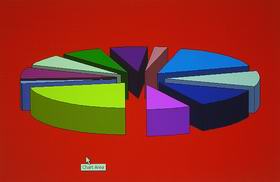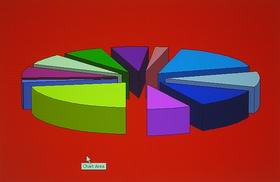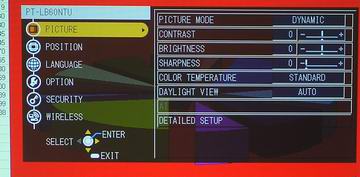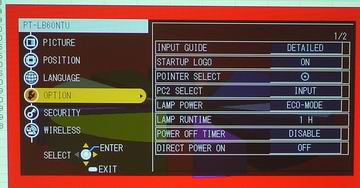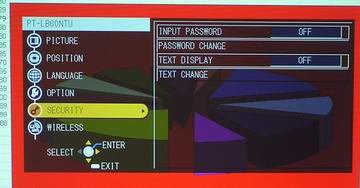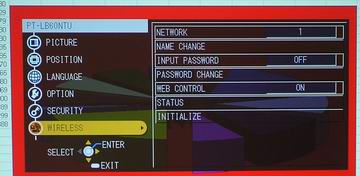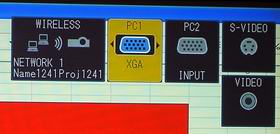Panasonic Daylight View
Last year we reviewed two Panasonic projectors (LB20U, and LB30NTU - the LB60NTU's predecessor). Both sported Panasonic's Daylight View. Although Panasonic makes huge claims for what Daylight view does - adjust the image automatically and dynamically to compensate as best possible for ambient light, - we found Daylight Wiew to perform well, and be of real benefit, but not live up to the full hype. The LB60 series now boasts second generation Daylight View, with slightly improved performance.
What does Daylight View do? First, the LB60NTU has a light sensor on the top of the projector, so that the projector is "aware" of the level of room lighting. Based on that, the projector's firmware, adjusts the image to compensate. Mind you, it can't make the projector any brighter, but what it does, is increase the color saturation, and it would seem, contrast, gamma, and other parameters that work well to keep colors, particulary softer, less saturated ones, from washing out.
The two images here, show the differences that Daylight View imparts. So that we could illustrate it, we left the room lighting the same, but in the first image we covered the sensor, simulating a dark room, and in the second image, we made sure plenty of light was hitting the sensor to get Daylight View to "do its thing".
You can notice several changes between the two. On the second image you will note that darker shades in the front (depth) of the slices are lighter and results in less contrast between the dark front, and the lighter top of the slices. This is most noticeable on the yellow and purple front slices and the light blue slice on the right of the pie. However, by making those dark shades lighter, they would stand up better to bright lights. Most unfortunately, the images above do not really show the difference, as well as when viewed "live".
Bottom line - Daylight View is a very nice touch. It works as suggested, but, it doesn't make the "night and day" kind of difference Panasonic alludes to. It does enhance an image to allow it to hold up better in ambient light. This is the same reason many other projectors offer multiple presets like "Bright" and "Dynamic", as well as brightness, contrast, and color saturation controls. In the case of the Panasonic, LB60NTU, this is all handled automatically. The projector senses the room lighting and digs into its bag of possible compensations, and picks out one that should do the best job.
Since few presenters will rarely try to tweak their projector's settings moments before their presentation begins, having Daylight View, should prove to be a plus.
So, overall, what can we say about the LB60NTU and its almost identical LB60U which should have identical image quality performance? The projector is very bright, especially for one under 6 pounds, and can handle presentations in almost any sized room from small to large, with full bright lighting in the smaller rooms, and a fair amount in even a hotel ballroom.
Colors are rich, and accurate, the image (including small text), is very sharp, and it handles higher resolution computer sources about as well as can be expected. Lastly Panasonic's Daylight View, may not change the world, but it is a nice, fully automatic touch that does improve the overall picture when the lights get turned up.
Panasonic PT-LB60U/NTU Menus
Hitting the Menu button on the remote, or the control panel brings up the the menu seen on the right. The primary menus are all located on the left, with the first of those being the picture menu. As you can see here, the Picture menu choices are displayed.
The Picture menu handles standard functions, including contrast and brightness, color temperature and sharpness. In addition, you have the control of Panasonic's Daylight View, as described in the previous section. The first item, labeled Picture Mode, offers selection of one of the Panasonic LB60's presets, including Dynamic, Natural, and Standard.
Other primary menus include the Options menu shown to the right. From this menu, you control, among other things, creation of a startup screen logo, choice of full power on the lamp, or "eco-mode", the auto-off functions, if there is no source.
You also have the ability to set the 2nd computer port, to function as a computer input, or alternately as a monitor out, whichever you need at the time.
The Security menu allows you to password protect the projector - making it non-functional to those without the password. This is generally considered to be a theft deterrent, (assuming the thieves will not steal the projector because they know they won't be able to use it - a big assumption).
The next menu to look at is the wireless menu, shown here. Passwords are used to restricgt access to the wireless handling capabilities of the "NTU" version of the LB60. You also have the ability to control the projector over the internet through the projector's networking functions - for "command and control.
One very interesting feature worth noting about the LB60NTU's wireless capabilities, is that, unlike most other projectors with wireless operation, the Panasonic handles audio as well as video. This is a real plus for those that want to transmit a video clip with sound, or just an audio clip. It's a real plus, and for some, that ability to wirelessly transmit audio, may be the deciding factor for choosing the LB60NTU over other wireless projectors.
Since the LB60NTU supports 802.11g, as well as the older 802.11b, if your computer is pumping out a "g" signal, the video speed is impressive. No, it can't do full screen 30 frames per second, but it can produce a respectable sized video image, (I'd estimate around 25% of the screen area, with fast, smooth motion.
The menu shown at the right is the source control, which allows you to select between the video inputs, the two computer inputs (assuming you have computer 2 set as an input, and not as a monitor output), and the wireless system.
Panasonic offers one of the most sophisticated wireless networking capabilities that I have seen. I reviewed it previously with the LB60NTU's predecessor, the LB30NTU. When I reviewed the LB30NTU last year, I installed the wireless software on my laptop and did get to use the wireless capabilities, which worked extremely well.
This year, I had less time for testing as the LB60NTU is part of the Six projector comparison review, and I have been working with the six projectors over a total of about 2 weeks. I did not run the LB60NTU in wireless mode, but would expect it to perform very similarly to the LB30NTU, as the LB60NTU is simply an "evolutionary" upgraded version of the LB30NTU. For more information you can click here, and scroll down, to see my impressions on the wireless networking from last year's LB30NTU review.
The Panasonic LB60NTU can have up to 16 computers tied into it's wireless capabilities, and you can have thumbnails of what's on each of the 16 computers, on the screen at one time, to choose between them. That really is a nice touch if you do have a large group, for some applications where you need to jump from one computer to the next.
A more significant feature is the ability to split the screen into four quadrants and have up to 4 computer's materials displayed at one time. This was very impressive, and the 1/4 sized images are far more usable than the more numerous thumbnails.
Also for more information, I'd like to refer you to the brochure, which is very helpful. Click here to go to the LB60NTU in our database, and download the brochure (a multi-page pdf file). It contains a lot of information regarding the wireless capabilities.
Panasonic PT-LB60U/NTU Menus

